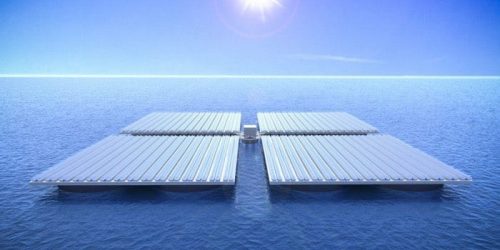New research published this week by the US Department of Energy’s National Renewable Energy Laboratory (NREL) has highlighted the “untapped potential” of combining floating solar PV projects and hydropower plants.
According to the NREL’s research, hybrid systems combining floating solar panels and hydropower plants may hold the “technical potential” to produce a “significant portion” of the necessary electricity generated across the globe.
Published in the journal Renewable Energy, the authors determine that adding floating solar panels to bodies of water that are already in use as hydropower stations could yield as much as 7.6-terawatts (TW) of potential electricity each year from solar PV systems alone, or around 10.6TWh of potential annual generation.
Published in the journal Renewable Energy, the authors determine that adding floating solar panels to bodies of water that are already in use as hydropower stations could yield as much as 7.6-terawatts (TW) of potential electricity each year from solar PV systems alone, or around 10.6TWh of potential annual generation.
Moreover, these figures do not include power generated by the hydropower plants.
“This is really optimistic,” said Nathan Lee, a researcher with NREL’s Integrated Decision Support group and lead author of a new paper published in the journal Renewable Energy.
“This does not represent what could be economically feasible or what the markets could actually support. Rather, it is an upper-bound estimate of feasible resources that considers waterbody constraints and generation system performance.”
In other words, the articles looks only at the theoretical availability of bodies of water used for hydropower, not whether they are technically and economically feasible to develop with floating solar PV.
This technicality of the research is also particularly relevant in the United States, where floating solar PV has remained a nascent technology, despite rapid uptake around the globe. Floating solar PV has become a necessary option in countries and locales where free space is rare, such as in Korea, Japan, and Taiwan, making ground-mounted solar systems both economically and technically difficult.
Several such projects have already sprung up, including the ill-fated project atop Japan’s Yamakura Dam – which was damaged and caught fire a year ago after it was hit by Typhoon Faxai – and a small floating solar plant atop Portugal’s Alto Rabagão dam.
But the potential scope of power generation is significant. The research points to previous NREL work which estimated that installing floating solar panels on man-made US reservoirs could generate approximately 10% of the country’s annual electricity production.
“Floating solar is a new industry enabled by the rapid drop in the price of solar PV modules,” said Adam Warren, director of NREL’s Integrated Applications Center, back in late-2018. “The cost of acquiring and developing land is becoming a larger part of the cost of a solar project. In some places, like islands, the price of land is quite high, and we are seeing a rapid adoption of floating solar.”
Globally, NREL estimates there are 379,068 freshwater hydropower reservoirs which could theoretically host a floating solar PV project in conjunction with the existing hydropower facilities.
This, again, is just theoretical, and the research explains that additional siting data is necessary prior to any potential implementation, as some reservoirs may be dry for parts of the year or may not otherwise be conducive to hosting a floating solar PV plant.
However, the benefits of combining floating PV with hydropower are more than just increased power generation. A combined system would reduce transmission costs by linking into a common substation – rather than requiring separate interconnection infrastructure – and floating solar can reduce reservoir evaporation, thus increasing hydropower generation.
NREL explain that the biggest potential for hydropower and floating solar PV combinations is the balance they provide – with solar power generating significant power during the dry seasons and hydropower generating electricity during rainy seasons. Further, NREL posit that one scenario could see pumped storage hydropower store excess solar generation for use in times of peak demand.







